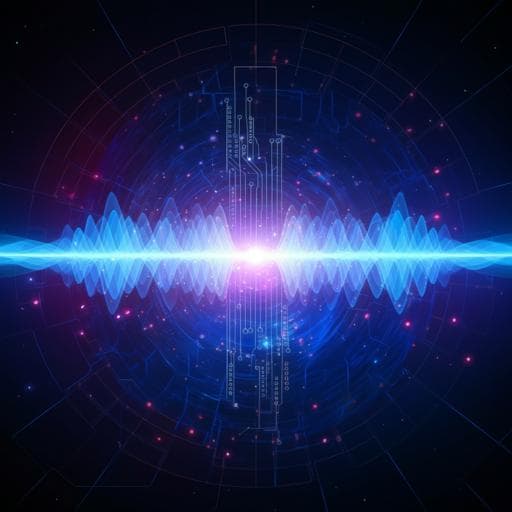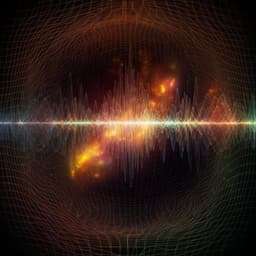
Physics
Revealing inherent quantum interference and entanglement of a Dirac particle
W. Ning, R. Zheng, et al.
This groundbreaking research by Wen Ning and colleagues uncovers the quantum interference behavior of Dirac particles beyond so-called Zitterbewegung. Their findings reveal intriguing interference patterns characterized by Wigner function negativity and pseudospin-momentum entanglement, confirmed by experiments with superconducting qubits. Explore the fundamental quantum nature of Dirac particle dynamics and their implications for quantum technology.
~3 min • Beginner • English
Introduction
The study addresses the fundamental origin of Zitterbewegung (ZB) in Dirac particles. While the Dirac equation is foundational to modern physics and predicts phenomena such as spin-1/2 and antiparticles, the dynamical feature of ZB—oscillatory motion arising from interference between positive- and negative-energy components—remains elusive and experimentally inaccessible for free electrons due to the Compton-scale amplitude and Heisenberg limits. Moreover, ZB-like effects have classical analogs in wave systems, raising the question of whether ZB in Dirac systems is rooted in uniquely quantum interference that persists even without a superposition of energy branches. The purpose is to reveal and characterize a universal quantum interference pattern in phase space (position-momentum) that underlies and extends beyond ZB, identifiable by Wigner function negativity and entanglement between internal (pseudospin) and external (momentum/position) degrees of freedom, and to confirm these features via quantum simulation with superconducting circuits.
Literature Review
Prior works have simulated or discussed ZB across diverse platforms: circuit QED, trapped ions, ultracold atoms, semiconductors, graphene, and moiré excitons, elucidating aspects of the effect but also highlighting its non-uniqueness to quantum Dirac particles due to classical analogs in photonic lattices and other wave systems. Foundational debates persist on the assignment of positive/negative energy components to single particles and the observability of ZB. Theoretical proposals predicted phase-space interference for states with both energy branches in specific settings, and relativistic phenomena such as Klein tunneling have been explored in trapped ions and optical lattices. However, a clear demonstration that intrinsic phase-space quantum interference exists even without ZB (i.e., within a single energy branch) and its experimental characterization via Wigner negativities and pseudospin-momentum entanglement remained lacking.
Methodology
Theory: The work considers 1D Dirac dynamics with Hamiltonian H0 = c σx p + m c^2 σz. In the momentum representation, for a given p, eigenenergies are Ep = sqrt(p^2 c^2 + m^2 c^4). Starting from an initial spin-position product state, dynamics induce pseudospin-momentum entanglement and non-Gaussian deformation of wavepackets due to the nonlinear Ep(p), yielding phase-space interference visible in Wigner functions conditioned on pseudospin outcomes and, under certain conditions, even unconditionally.
Experimental simulation: A superconducting circuit emulates the Dirac spinor. The internal degree of freedom is encoded in a superconducting Xmon qubit (transition frequency ω0/2π = 5.26 GHz) and the external degree of freedom in a bus resonator mode (quadratures x = (a† + a)/√2 and p = i(a† − a)/√2). The qubit is subject to two longitudinal parametric flux modulations with amplitudes εj and frequencies ν1/2π = 160 MHz, ν2/2π = 33.4 MHz, and a continuous transverse microwave drive of amplitude Ω. With ω1 = ω0 + 2ν1, the resonator couples to the qubit at the second upper sideband; the effective coupling strength is η ≈ J2(μ)/2 with μ = ε1/ν1 (J2 is a Bessel function). For Ω ≫ ν1, the transverse drive converts the interaction into an equal mix of rotating and counter-rotating terms, realizing the effective Dirac Hamiltonian in the rotating frame with mappings: c = √2 η, m c^2 = Ω^2/4, pseudospin operators dx = i(|g⟩⟨e| + |e⟩⟨g|) and dz = |e⟩⟨e| − |g⟩⟨g|. The effective sideband frequency is ω1/2π = 5.584 GHz.
Initialization: The resonator and qubit are prepared in their ground states. A resonator displacement prepares a coherent state |√2⟩ (momentum translation p0 = √2). A qubit π/2 pulse prepares |+⟩, yielding an initial product state of qubit and resonator.
Evolution and readout: After an evolution time under the engineered Hamiltonian, modulations and drive are turned off. Wigner tomography is performed by phase-space displacements D(γ) followed by resonant coupling to an ancilla qubit; from the measured photon-number parity Pn(γ), the resonator Wigner function W(x, p) = Σn (−1)^n Pn(γ) is reconstructed (with x = √2 Re γ, p = √2 Im γ). Conditional Wigner functions are obtained by postselecting on the qubit outcomes |g⟩ or |e⟩; unconditional Wigner functions are measured irrespective of qubit outcome. The qubit’s reduced density matrix is measured to compute the von Neumann entropy S(ρq). The mean position ⟨x(t)⟩ is extracted from reconstructed Wigner functions. Numerical simulations accompany experiments to validate observations and explore regimes difficult to prepare experimentally (e.g., positive-energy branch only).
Key Findings
- Revealed a fundamental phase-space quantum interference underlying Dirac dynamics, manifested by Wigner function negativity and pseudospin-momentum entanglement. This interference underlies but goes beyond Zitterbewegung and can persist even without negative-energy components.
- Experimental observation: Starting from a Gaussian-like coherent state, after 330 ns of evolution under the engineered Dirac Hamiltonian, the resonator’s Wigner functions conditioned on |g⟩ and |e⟩ show splitting into two counterpropagating lobes with pronounced regions of negativity between interfering features, evidencing non-Gaussian deformation and quantum interference. The unconditional Wigner function shows corresponding features when integrating over pseudospin.
- Entanglement: The qubit (pseudospin) becomes entangled with the resonator (momentum/position). Measured von Neumann entropy of the qubit versus time agrees with numerical simulations, showing growth toward strong entanglement (with fast oscillations attributed to modulation sidebands).
- Zitterbewegung: The time evolution of the mean position ⟨x(t)⟩, extracted from measured Wigner functions, exhibits ZB oscillations matching simulations, confirming that the observed spatial trembling arises from deeper quantum phase-space interference.
- Positive-energy branch regime (numerical): Even when restricting to the positive-energy branch with a Gaussian momentum distribution (m = p0 = 1, c = 1, δp ≈ 1), unconditional Wigner functions show time-dependent interference fringes and negativity without ZB, and the pseudospin-momentum entanglement entropy increases with momentum spread δp, independent of evolution time.
- Klein tunneling in a linear potential: By applying a continuous resonator drive of strength ε = 2π × 0.39 MHz to realize V = √2 ε x and omitting the second modulation to simulate a massless particle, the phase-space evolution is dragged along the p-axis by √2 ε t while x-motion is unaffected. After 288 ns, conditional and unconditional Wigner functions display cat-like mesoscopic superpositions. Measured ⟨x⟩ and ⟨p⟩ evolutions show two wavepackets with the same instantaneous momentum but moving in opposite x-directions, consistent with Klein tunneling interpretations.
Discussion
The results directly address whether ZB in Dirac particles is rooted in uniquely quantum behavior: observed Wigner negativities and pseudospin-momentum entanglement demonstrate that the trembling motion has a quantum interference origin in phase space. Crucially, simulations reveal interference patterns even when ZB is absent (single energy branch), establishing that such phase-space interference is a universal, inherent feature of Dirac dynamics beyond classical analogs of ZB. The circuit-QED implementation enables controlled access to relativistic-like regimes and potentials, allowing observation of mesoscopic superpositions and Klein tunneling dynamics. These findings clarify the nature of Dirac particle dynamics and distinguish genuinely quantum features from classical wave analogs, with implications for exploiting nonclassicality as a metrological resource.
Conclusion
The study uncovers and experimentally validates an inherent phase-space quantum interference in Dirac dynamics, characterized by Wigner negativity and pseudospin-momentum entanglement, which underlies and extends beyond Zitterbewegung. Using a superconducting qubit–resonator platform, the work observes conditional Wigner negativities, ZB in mean position, and simulates Klein tunneling in a linear potential generating cat-like states. These advances deepen understanding of Dirac particle dynamics and provide nonclassical resources potentially useful for quantum-enhanced sensing. Future research could extend to higher-dimensional Dirac simulations, other external potentials and fields, tunable mass regimes, decoherence-resilient generation of larger mesoscopic superpositions, and quantitative exploitation of the observed nonclassicality for metrology.
Limitations
Experimentally preparing entangled positive-branch-only states is difficult, so some phase-space interference results were demonstrated numerically. Engineering a sharp step potential is not feasible in the current setup; a linear potential was used instead. High-frequency oscillations in measured entropy and mean position originate from parametric modulation sidebands, reflecting implementation-induced vibrations. Realization relies on rotating-frame approximations and parameter regimes (e.g., Ω ≫ ν1), and decoherence and control imperfections may limit state purity and Wigner negativity.
Related Publications
Explore these studies to deepen your understanding of the subject.







